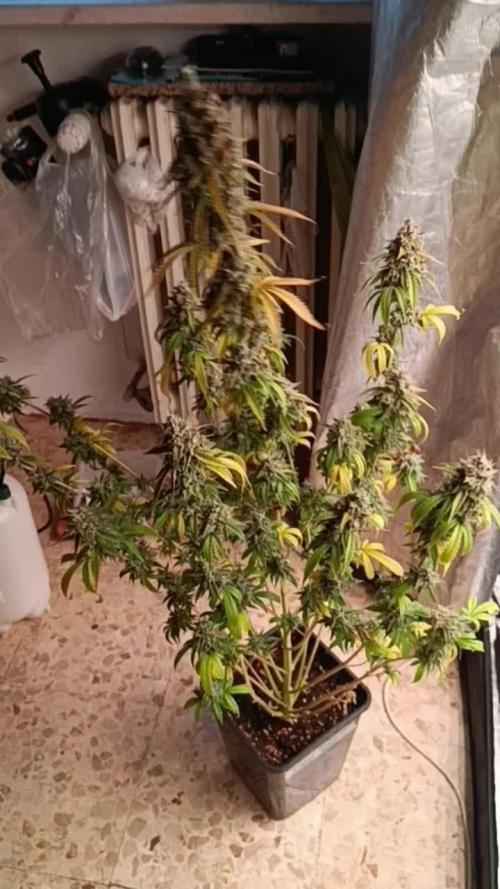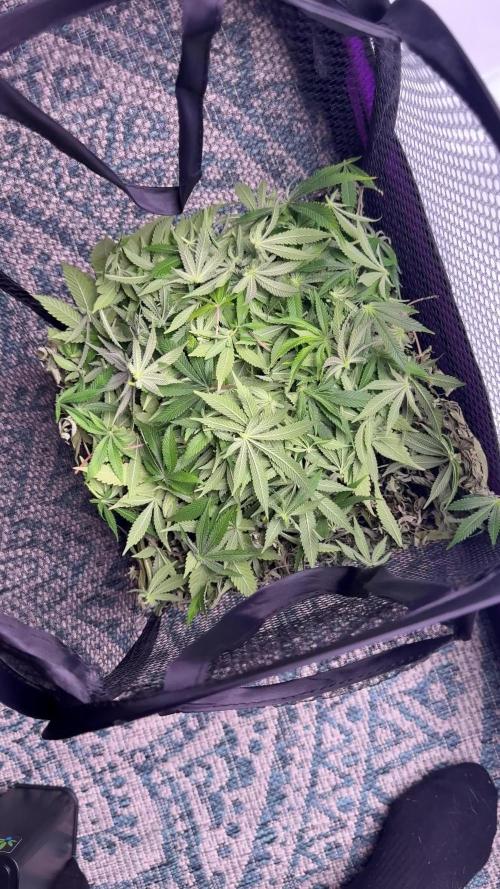The Grow Awards 2026 🏆 



































Likes
Comments
Share


@Ultraviolet
Follow
Carotenoids absorb light in blue-green region of the visible spectrum, complementing chlorophyll's absorption in the red region. They safeguard the photosynthetic machinery from excessive light by activating singlet oxygen, a oxidant formed during photosynthesis. Carotenoids also quench triplet chloryphyll, which can negatively affect photosynthesis, and scavenge reactive oxygen species (ROS) that can damage cellular proteins. Additionally carotenoid derivatives signal plant development and responses to environmental cues. They serve as precursors for the biosynthesis of phytohormones such as abscisic acid () and strigolactones (SLs). These pigments are responsible for the orange, red, and yellow hues of fruits and vegetables, while acting as free scavengers to protect plants during photos.
Beta-carotene is most prevalent provitamin A carotenoid, commonly found in orange and yellow fruits and such as carrots, sweet potatoes, and mangos. Additional carotenoids include lycopene, lutein, and zeaxanthin, which possess antioxidant and photoprotective properties. In, Vitamin A exists in the form of carotenoids, are pigments responsible for. Vitamin A is classified as a soluble vitamin.
Vitamin B plays a crucial role in plant growth and development, serving as a coenzyme in numerous metabolic reactions underpin plant growth and maintenance. It aids in metabolizing essential nutrients for growth and development and enhances their responses to biotic and abiotic stress. Vitamin B supports root development, reducing transplant shock, and promotes shoot growth, particularly in slow-growing plants
Vitamin B1, also as thiamine diphosate, is integral to pathways such as glycolysis and the tricarboxylic acid cycle. Vitamin B3, or nicotinamide/niacin, acts as a biostimulant, improving growth and. Vitamin B6 functions as an antioxidant and cofactor, playing a significant role in plant.
Vitamin C, referred to as ascorbic acid is another vital nutrient for plants, aiding in growth and offering protection against excessive light. It serves as a red buffer, crucial for regulating synthesis. Vitamin C assists enzymes involved in photosynthesis, hormone production, and the regeneration of antioxidants. Furthermore, it acts as coenzyme in the xanthophyll cycle, converting energy into heat to protect plants light-induced damage.
RAW GROW is a thoroughly tested blend all RAW Soluble plant nutrients essential elements, and supplements as an optimal all base "Grow" horticultural fertilizer. It is utilized throughout the entire vegetative stage. Its composition includes plant protein hydrolysate, mono potassium phosphate, potassium sulfate, cane molasses, sodium borate, copper sulfate, iron DTPA, magnesium sulfate, manganese sulfate sulfate, and azomite. Additionally, it contains non- food ingredients such as humic acids derived from leonardite and peat, kelp (Ascophyllumosum silicon dioxide derived diatomite, and yucca extract. Seedlings or young plants can be fed with 200-400PpM, teenage plants with maturing root zone can be given 350-550 PPM, and mature plants require 600-1000 PPM. By closely monitoring plant growth and adjusting feeding levels, one can an understanding of the quantity to provide When starting, it is advisable to err on the side of caution and adopt a "less is more" approach.
One-thousandth of a gram is one milligram, and 1000 ml is one liter, so 1 ppm = 1 mg per liter = mg/Liter. PPM is derived from the fact that the density of water is taken as 1kg/L = 1,000,000 mg/L, and 1mg/L is 1mg/1,000,000mg or one part in one million. One-thousandth of a gram is one milligram, and 1000 ml is one liter, so 1 ppm = 1 mg per liter = mg/Liter. PPM is derived from the fact that the density of water is taken as 1kg/L = 1,000,000 mg/L, and 1mg/L is 1mg/1,000,000mg or one part in one million.
Likes
6
Share


@BigDripFelgo
Follow
Yellow Zushi is growing very well and uniform, looks like she is training herself to stretch lower branches up. Looking healthy and growing fast. Thinking of topping main branch but not sure yet since I also want to start taking clones soon!
Likes
41
Share


@Silverback_Guerilla
Follow
11/30:
I fed them today and supercropped the taller one a little bit. Just trying to encourage her lowers to compete for apical dominance.
I raised the lights another few inches
12/1:
I raised the lights about a foot because of a couple of taller plants, so these girls and most of the others are on a platform so as to be within 15 inches of the lights. Their platforms are some of the shortest, and I think they're about to catch up with the others.👍
12/2:
Busy with life...didn't do much.
Very cold days, so the high temp in the closet was 72f today👈
12/4:
Switched to 13/11....afraid of it taking too long to flower and ending up with a bunch of pain in the ass 5-footers..
Likes
11
Share


@Kardo
Follow
Die trichome sind alle milchig ich warte noch 1 letze Woche und dann kommt die Ernte 😊👌🏻
Danke @skunkydog für die Unterstützung mit vielen Infos
Mein erster Grow und ich bin bis jetzt zufrieden die Blüten sind richtig schön geworden
Likes
Comments
Share


@Dankmark420
Follow
Just transplantere into the autopot system and the girls didnt even slack for one day before bouncing back and starting to grow some more🤩😍
After two days we put up a trellis🙌🏼
Likes
178
Share


@NuggetPawn
Follow
Bit late posting this but the pictures are from D70, with work I didn’t have time until now.
They’re still filling out the room ever so slightly. The girl at the front is suffering from light stress even though she’s the shortest, I have dimmed the light above her down to 70%. Out of all the the plants she has been the most difficult to manage from the start and has the smallest root mass. The other plants seem to be handling 100% with no issues.
I have to say, at this stage of the grow, they do smell nicer than Strawberry Lemonade, very sweet and perfume like, harder to grow it seems but I am looking forward to trying her in August!
Thanks guys!
Likes
7
Share


@Horizon_Grow
Follow
Due to construction and revamping of our space, we had to leave all seedlings in their germination dome for approximately a month before getting them into veg. In order to not run into any space issues within the small dome, these young plants were kept under a low-wattage fluorescent tube to avoid any growth which may have been "too vigorous."
VEG WEEK 1:
03/09/2021: (Image 1)
Each plant was potted into, and fed with the following nutrients during transplant:
1. 5l FF F1 medium
2. GHF: Biogrow - 15g worked into medium
3. Wormcastings (workd into medium and astop dress)
4. Organics Matter Mycoroot Supreme -placed at the bottom of the planting hole.
5. Watered each plant with a Silicon Plus feed solution .
07/09/2021: (Image 2)
- All plants are now in 5l pos with Freedom Farms F1 medium, and are in their new veg home under a 3500K 320W Quantum Board.
- The 3 weakest seedlings of the total 19 seeds (1x Crit and 2x PC) were placed on the left side of the tent, and in different pots, as they are obviously struggling and may not even make it into our final flower room.
Likes
1
Share


@Yisusondahood
Follow
Este video es del día 42 de vida de la Blue Mazar Auto. Regué 3/4 de bokashi de flora y 1/4 de bokashi de vege de Vamp. También usé 25 ML de Vampimelaza y Micorrizas de Namasté. Viene muy bien, compacta y frondosa.
Ya de a poco empieza tímidamente a mostrar los primeros tricomas.
Likes
9
Share


@d0cterstrain
Follow
looking good. up potted and rocking. waiting till I get my first clones so I can flower these girls.
Likes
12
Share


@Bluemels
Follow
Tag 123: Die Fat Banana riecht sehr süß. In einer Woche ist schon ernte! 😁
Likes
23
Share


@Kakui
Follow
V4, están creciendo rápido, desde este punto empezaré con una EC de riego más alta 1.5~1.8, hace 3 días que aparecieron las primeras hojas verdaderas, por lo cual la etapa de vegetación ha iniciado.
V6, el día anterior tuvieron un riego con pH 6.2 y EC 1.7, se me pasó el agua y quedaron algo tristes, pero ya se recuperaron hoy, todas las stash presentan puntos de decoloración en las primeras hojas, las cookies están en perfecto estado. Están comenzando a salir raíces por el fondo de los vasos(algo que nunca me había pasado con otras genéticas) además se ven muy gruesas las raíces, están pidiendo transplante ya, en unos días serán transplantadas.
Likes
6
Share


@Silverback_Guerilla
Follow
10/13:
I fed her about 24 ounces of compost tea today. I had brewed 5 gallons of tea using 90% rainwater collected the day before, and 10% aquarium water. My tea contained about 2 cups of very rich compost a handful of biochar, a tablespoon of 7 diff species of endo-mycorrhizal fungi + 25 species of beneficial bacteria, 8 tablespoons of big bloom (mainly for the earthworm castings), 2 tablespoons of liquid molasses, and a tablespoon of kelp me kelp you. It had been brewing for 48 hours and was very frothy.
I'm seeing signs of calcium deficiency on a few plants today, but the tea should correct that. I'll add cal/mag to the watering regimen anyway.
10/14:
With so much light and airflow, she's drying out very quickly.
I fed her about a half-gallon of water with grow big, big bloom, kelp me kelp you, boomerang, cal-mag+iron, armor si, and soluble humic acid.
I also foliar fed her a few times with humic acid and big bloom.
10/15:
I foliar fed with big bloom and a little kelp a few times today and peeled back the insulation in the attic above the closet now that it's getting colder outside. It brought my daytime temp down to 81f!
10/16:
I fed her about a quarter-gallon containing all the good stuff, at full strength for the first time. I also misted her really well with Ph adjusted spring water a few times throughout the day, just to rinse off any built-up nutes. She never showed any signs of a calcium deficiency, but I dosed her heavy with cal-mag with this feeding anyway.
I did some leaf-tucking today, but have decided not to FIM her. I really don't want to increase her individual footprint since she has so many neighbors.
10/17:
I rearranged the garden a little bit and sprayed her down with ph adjusted tap water a few times today. She's looking great!
10/18:
Today, I did a myco root drench, with a little added boomerang for all the aminos, vitamins, and earthworm castings, and some cal-mag.
I soaked her thoroughly with about 3/4 gallon and let her sit in her tray to soak it all up. I'll let her go completely dry before I feed her again so that she really drinks it all in next time.
I lowered the lights to 20 inches above her right at dark, so she'll wake up to an especially bright sunshiny day!
10/19:
I was gonna rearrange this morning and had no space to work with, so I moved the 4 smallest plants in the garden into the "upper deck." Now she has a little more elbow room.
It's the last day of week 3 and I'm really impressed with her progress. If I had more space to work with, I'd definitely be doing a little training to try and maximize my yield from her.
Likes
5
Share


@JohnnyBlaz3
Follow
Yesssss there we go, that's what I like to see!!! They are very healthy and thriving now that I got the light figured out a bit better. I will start turning up the power next week, right now it's at 65%. Started giving flower nutrients. Will remove the driver from the tent in a couple weeks. Overall I'm very happy with the tent situation right now. Cool to see how the plants recover from topping and training!!!
Likes
2
Share


@ErrorsSeeds
Follow
Day 22. Everything is normal. Looking good! Light regime day/night is 18/6.
Day 23. I continue to water. So, enter = 110 ppm , exit = 320... Next watering 60% of fertilizing.
Day 24. Made my video. Everything is excellent
Day 26. Plant starts emitting a slight odor of cut grass and marijuana. It is wonderful.
Day 27. I continue to water. Added 1,5 liter, no waste. The plant has a great appetite.
I trimmed 7 leaves to make more space for new shoots. Light odor.
Day 28. I added 2 liters of fertilizing solution: 590 ppm enter, 470ppm exit. The plant is growing well. I will water everyday from now on. Substrate gets dry quickly. One day fertilizing solution (food), one day just water. No flowers yet
Likes
24
Share


@el_cultivito
Follow
TOTAL YIELDS wet weight
Blue Dream 1 - 600.2 G
Blue Dream 2 - 552.9 G
Blue Dream 3 - 565.3 G
TOTAL Blue Dream - 1718.4 G
________________________________
Chemdog 1 - 616.9 G
Chemdog 2 - 598.1 G
Chemdog 3 - 558 G
TOTAL Chemdog - 1773 G
________________________________
TOTAL OVERALL - 3491.4 G
7.7 pounds wet
Likes
116
Share


@bioaccessory
Follow
Вот и подходит к концу наше увлекательное путешествие. С понедельника, 18/05 начал Pre-harvest Flush, всё идёт по плану. Я очень требовательно отношусь ко вкусу конечного продукта, поэтому стараюсь тщательно промывать растение (≈10 дней).
Шишки стали упругими, при прикосновении похожи на резиновый мяч, жду не дождусь, когда можно будет попробовать😋.
p.s. На последней картинке иллюстрация соответствия стрейна описанию из каталога - браво RQS!👍
Спасибо, что заглянули, и будьте здоровы! 🙏
Продолжение следует ...😶
Likes
37
Share


@DogDoctorOfficial
Follow
Grow Diaries: Week 9 Veg - Mentha de Croco Mutants
Hello, Grow Diaries fam! 🌱✨ Week 9 is here, and while our mutants are small, they’re undoubtedly mighty in beauty and character! Each plant continues to showcase its uniqueness, with details in the leaves that are nothing short of art. As always, patience is the key, and these beauties are teaching me that every step of this journey is worth it.
The Flip is Coming!
After much thought, I’ve decided to flip the entire room to a 11/13 light cycle. This means it’s time to identify males and let the females show their true potential. Here’s the plan:
• Why Flip Now?
Despite their smaller size, flipping now allows the plants to reveal their sex while keeping the room’s progress synchronized. This way, I can focus on the keepers and remove the males efficiently.
• Revegging the Favorites:
By flipping and selecting now, I’ll be able to reveg any standout females later. For those unfamiliar, revegging is a technique where, after flowering, you revert the plant back to a vegetative state. This method preserves genetics you love and allows you to grow clones or expand the line further.
👉 Benefits of Flipping and Revegging:
• Speeds up the identification process without needing clones first.
• Lets you preserve special traits in the plants.
• Adds flexibility in managing space and time.
Environment & Nutrition
This week, I’ve maintained a steady environment:
• Temps: 22°C with about 66% RH.
• Nutrients: Continuing with the Aptus Holland lineup—Regulator, Start Booster, and CalMag Boost. The All-in-One Pellets are still providing slow-release nutrition, and the plants seem to love it!
Watering from the bottom remains my go-to, helping keep gnats at bay while ensuring even root hydration.
The Photographer’s Eye
Once again, my Sony A6000 has been in action, capturing the stunning intricacies of these mutants. There’s something magical about zooming in on their delicate details, seeing the interplay of light, and appreciating every curve and serration. Pro tip: The right lens can make all the difference, giving you sharp, breathtaking shots.
Shout Outs & Gratitude
Big love and thanks to:
• Terpyz Mutant Genetics for these incredible seeds!
• Aptus Holland for keeping the nutrients dialed in.
• Pro Mix Soil for giving the roots a cozy home.
• TrolMaster for perfect environmental control.
• Future of Grow for the endless inspiration.
• Grow Diaries for hosting this amazing community.
And, of course, to all the growers, followers, and curious onlookers who make this journey even more special. Your support means the world! 💚
Join the Journey
Let’s connect beyond Grow Diaries! Follow me on Instagram and YouTube to catch exclusive updates, behind-the-scenes moments, and more. Together, let’s grow, learn, and inspire!
Genetics - Mentha De Croco
https://terpyz.eu/products/menta-de-croco-fern-type?_pos=1&_sid=e9237cbcb&_ss=r
DogDoctorOfficial Discount Codes @ terpyz.eu - DOCTOR 15% off
Nutrition - @aptusholland
https://aptus-holland.com/
Led Power @ F.O.G. Future Of Grow
https://www.thefuturofgrow.com/en/online-store/BLACK-SERIES-600-p489093171
Controls @ TrolMaster
https://www.trolmaster.eu/tent-x
As always thank you all for stopping by, for the love and for it all , this journey of mine wold just not be the same without you guys, the love and support is very much appreciloved and i fell honored with you all in my life
With true love comes happiness Always believe in your self and always do things expecting nothing and with an open heart , be a giver and the universe will give back to you in ways you could not even imagine so
As always, this is shared for educational purposes, aiming to spread understanding and appreciation for this plant. The journey with nature is one of discovery, creativity, and respect. Let’s celebrate it responsibly and continue to learn and grow together!
Growers Love To you All 💚
Likes
36
Share


@MadeInGermany
Follow
Info:
Unfortunately, I had to find out that my account is used for fake pages in social media.
I am only active here on growdiaries.
I am not on facebook instagram twitter etc All accounts except this one are fake.
Have fun with the update.
Hey everyone 😃.
Another week of beautiful growth goes by 😀.
She continues to develop very well and beautifully.
All shoots were topped up again.
I think I'll go back a few more times do topping before it goes into bloom :-).
The tent was cleaned and the humidifier refilled 👍.
Otherwise nothing exciting happened this week.
I wish you all the best and have fun with the update 👍.
Stay healthy 🙏🏻
You can buy this Strain at :
https://originalsensible.com/original-sensible-seeds-zkittlez~20503
Type:
Zkittlez
☝️🏼
Genetics:
Afghan Kush Indica x Grandaddy Purple x Grapefruit hybrid
👍
Vega lamp:
2 x Todogrow Led
Quantum Board 100 W
💡
Bloom Lamp :
2 x Todogrow Led
Cxb 3590 COB 3500 K 205W
💡💡☝️🏼
Soil :
Canna Coco Professional +
☝️🏼
Fertilizer:
Green House Powder Feeding
☝️🏼🌱
Water:
Osmosis water mixed with normal water (24 hours stale that the chlorine evaporates) to 0.2 EC. Add Cal / Mag to 0.4 Ec Ph with Organic Ph - to 5.5 - 5.8 .
























